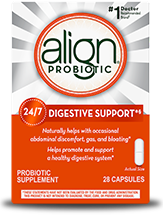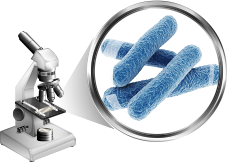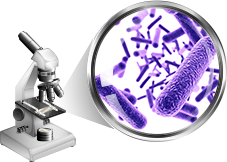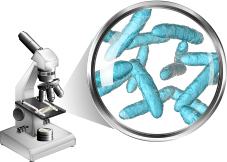Top 5 Probiotic
One of the fastest-rising supplement categories today is probiotics. These are live microorganisms, which are the “good” bacteria that help keep the “bad” bacteria in your stomach from overgrowing. Probiotics have been used in different forms going back hundreds of years to improve digestion and provide overall well-being.1 Modern science has recently unraveled the mystery behind how specific strains of these microbes work to help support healthy weight, digestive health, menopause, anxiety and mood, energy, immune and inflammatory response, and even memory.
This new popularity has led to hundreds of probiotic supplements flooding the marketplace. While these supplements all promise to deliver benefits, the reality is that too many fall short. Some of the most popular brands use ineffective types of probiotics or insufficient dosages. Others use strains of probiotics that do not have enough scientific evidence to support their claims. To make matters worse, we found that some popular probiotic supplements contain potentially harmful fillers.
How To Pick A Good Probiotic Supplement & Avoid The Junk
With so many options, it seems many of us might still be unclear about what to look for in a quality probiotic supplement. To help cut through the clutter, we have compiled months of research about the key probiotic strains that have been shown in studies to offer real benefits.
This short guide will help you know what to look for and what to avoid so you can make an informed decision regarding your probiotic supplement needs. We will also list out the top 5 probiotic supplements sold today.
Let’s take a moment to understand precisely how probiotics work and why it’s essential to add them to your daily routine.
Probiotics : What Are They All About?
Within our intestines is a complex world known as the gut microbiome, which comprises thousands of different types of bacteria, fungi, and even viruses. Some of the bacteria can offer significant health benefits, while others can be harmful.
A quality probiotic pill should contain a potent dose of friendly bacteria in different varieties. When consumed, probiotics will make their way to your colon, attach to the walls of your intestine, and begin to colonize. Assuming you take the right kind of probiotic that has clinically studied strains, as they grow, they can help improve digestion, absorb minerals and nutrients, produce vitamins, and rid the body of damaging toxins.
3 Things To AVOID
When Buying A Probiotic Supplement
1. LACK OF STRAIN DIVERSITY
Clinical studies have shown that specific probiotic strains can help with particular health concerns.19,20 While the human gut contains thousands of different bacterial strains, most probiotics only include a few generic Lactobacillus or Bifidobacterium strains. Look for a probiotic that has at least 14 unique strains to support proper microbiome balance.
2. CHEAP GENERIC STRAINS
Store shelves are filled with brands selling probiotics, listing cheap generic forms of popular strains on their labels. A 2018 study showed that not all probiotic strains produce the same results, even if they have the same name.21 Like most things in life, it all comes down to the details.
A high-quality brand will list the strain and a combination of letters and numbers, such as L. acidophilus La-14TM, known as a substrain. This unique identifier tells you that one or more clinical studies back the strain being used. Avoid probiotics that don’t list substrains, as that could be a warning sign that low-quality, generic, and possibly ineffective strains are used in the formula.
3. PLASTIC BOTTLES
Moisture vapor transmission rate (MVTR) studies on probiotics packaged in plastic bottles have shown that they can allow too much moisture to enter, causing lower strain survival rates and a shorter shelf life overall.22
Don’t throw away your hard-earned money on probiotics in cheap plastics bottles that can allow harmful elements to enter during storage and shipping, risking your probiotics arriving dead at your doorstep.
2024’s Top Probiotic Supplements
Our review encompassed 84 different probiotic supplements, putting each through our rigorous Review Scout assessment process. To determine 2024’s Top 5 Probiotic Supplements, we looked for predicted effectiveness, safety, return policy, and overall customer satisfaction.
#1 Stonehenge Health Dynamic Biotics

A+
Overall Grade
#1 Stonehenge Health Dynamic Biotics
-
OVERALL RATING
9.7/10
-
Predicted Effectiveness
9.7/10
-
Ingredient Quality
9.8/10
-
Value
9.5/10
-
Return Policy
9.8/10
-
User Rating
9.7/10
PROS
- 16 Diverse Probiotic Strains & 55 Billion CFUs
- Endorsed by a Doctor Specializing in Digestive Health
- Includes ALL Top-6 Strains & Prebiotic NutraFlora®
- Dark Amber Glass Bottle for light and moisture protection
- Clinically Studied sub-strains listed on the label
- Vegetarian acid-resistant capsules
- Non-GMO, Vegetarian, Gluten Free, and No Preservatives
- Verified 90-day 100% money-back return policy
CONS
- Often out of stock due to high demand
Why We Chose It
Stonehenge Health’s Dynamic Biotics is Review Scout’s top choice. This formula contains a potent 55 Billion CFU dose of 16 diverse clinically studied strains, including all six of the essential strains L. Gasseri, L. Rhamnosus, L. Reuteri, L. Acidophilus, B. Bifidum, and B. Longum.
Dynamic Biotics’s label lists each probiotic and its unique identifying substrain allowing for maximum traceability instilling confidence that one or more clinical studies back each strain. We were happy to see that this formula includes the prebiotic NutraFlora® to help nourish the probiotics supporting their ability to survive and grow.
In reviewing dozens of probiotic brands, we found that most package these light and moisture-sensitive live cultures in cheap plastic bottles, increasing the risk you will receive a probiotic that is dead on arrival. We liked that Stonehenge Health uses a dark amber glass bottle to protect its probiotics and improve survivability. With the correct probiotics and prebiotics at the proper CFU strength, Dynamic Biotics has what it takes to help support healthy weight, digestive health, menopause, a robust immune system, and other essential health benefits.
We were able to verify that Stonehenge Health’s formula does not contain any synthetic fillers or artificial ingredients, is non-GMO, and uses vegetarian capsules. Stonehenge Health backs its products with a no-questions-asked, 90-day money-back guarantee and is one of the few brands endorsed by a board-certified doctor specializing in digestive health. We also like that they offer customers discounts on bundles. Click on the link below to see their current specials.
*Results are based on user-generated experiences with these products, and individual results may vary. Please refer to the manufacturer’s product website for detailed information.
#2 Renew Life Extra Care Probiotics

A-
Overall Grade
#2 Renew Life Extra Care Probiotics
-
OVERALL RATING
8.9/10
-
Predicted Effectiveness
9/10
-
Ingredient Quality
9.2/10
-
Value
8.7/10
-
Return Policy
8.9/10
-
User Rating
8.6/10
PROS
- 12 Diverse Probiotic Strains
- 50 Billion CFUs
- Clinically Studied sub-strains
- Veggie caps, Non-GMO, Gluten & Soy Free
CONS
- Only includes 2 of the Top-6 Strains
- Does not include any Prebiotics
- Plastic bottle instead of glass
- User complaints new formula not as effective
- Quality control concerns about safety seals
- Limited return policy
Why We Chose It
Renew Life Extra Care Probiotics contains 12 varieties of strains and lists each substrain on the product label. We were happy to see that each dose is 50 billion CFUs but was disappointed that the formula lacked prebiotics.
While Renew Life has decent diversity of strains, it fell short of our recommended minimum of 14 strains. We were perplexed why this brand only included 2 of the top-6 strains, L. Rhamnosus and L. Acidophilus, leaving out the highly researched and effective L. Gasseri, L. Reuteri, B. Bifidum, and B. Longum.
This product comes in vegetarian capsules, great for health-conscious users. Still, the inclusion of medium-chain triglycerides in the formula may be the reason behind reports of digestive discomfort by some users. A common and growing complaint amongst other users is that a recent change in the formula has rendered the product less effective.
Renew Life offers a 60-day money-back guarantee, but we would have preferred to see a 90-day guarantee to allow more time for consumers to assess if it is right for them.
*Results are based on user-generated experiences with these products, and individual results may vary. Please refer to the manufacturer’s product website for detailed information.
#3 Florastor Daily Probiotic

B-
Overall Grade
#3 Florastor Daily Probiotic
-
OVERALL RATING
8.1/10
-
Predicted Effectiveness
8.6/10
-
Ingredient Quality
9/10
-
Value
7.5/10
-
Return Policy
7/10
-
User Rating
8.5/10
PROS
- Contains clinically researched strain Saccharomyces boulardii lyo CNCM I-745
- Veggie caps, Non-GMO, & Gluten Free
CONS
- Only contains one clinically studied strain
- Limited potency of 10 Billion CFUs
- Contains dairy and No Prebiotics
- No company guarantee or return policy
Why We Chose It
Florastror is a yeast-based probiotic with one clinically studied strain, Saccharomyces boulardii lyo CNCM I-745. Each capsule of Florastor contains 250 mg, which is equivalent to 5 Billion CFUs. A single dose is two capsules, 500 mg, for 10 Billion CFUs.
Studies on CNCM I-745 indicated positive results, especially for addressing antibiotic-induced diarrhea, but used doses of three to four capsules per day. Florastor’s suggested use is two capsules taken 1-2 times per day, a maximum of four capsules in a day, making a one-month supply of 60 to 120 capsules. Users have complained that Florastor only sells their product in 18, 20, 30, 50, and 100 counts, none of which is a one-month supply. This brand’s 100-count package cost $62, making it one of the most expensive probiotics we have reviewed. But, if you take four capsules per day, this would be the cost equivalent of $74.40.
This formula lacks the benefit of a diversity of strains and the potency of higher CFU strength to address broader digestive health issues. A notable downside is that Florastor contains milk (lactose), eliminating those who are lactose intolerant. Reviews have been mixed from users, with some stating they did not get their desired results. Florastor does not have a guarantee policy listed on their site, leaving consumers to deal only with the refund/return policy from the retail store they purchased it in.
*Results are based on user-generated experiences with these products, and individual results may vary. Please refer to the manufacturer’s product website for detailed information.
#4 Align Probiotic

C+
Overall Grade
#4 Align Probiotic
-
OVERALL RATING
7.9/10
-
Predicted Effectiveness
7.5/10
-
Ingredient Quality
7.2/10
-
Value
7.5/10
-
Return Policy
8.5/10
-
User Rating
8.7/10
PROS
- Contains one out of our top-6 strains
- Veggie caps, Gluten & Soy Free
CONS
- Only contains one clinically studied strain
- Limited potency of only 1 Billion CFUs
- Contains unhealthy additives and fillers
- Does not contain prebiotics
- Limited 60-Day return policy
Why We Chose It
Align Probiotic is a popular product thanks in part to their heavy television advertising. The formula contains a single clinically studied strain, Bifidobacterium Longum 35624™, formerly known as Bifidobacterium infantis or Bifantis. It has a limited potency of only 1 Billion CFUs per dose.
While we liked that this formula contains the strain B. Longum, one of our top-6 recommended strains, it is crucial to have a diverse array of strains. And so, we were disappointed to see Align was missing L. Gasseri, L. Rhamnosus, L. Reuteri, L. Acidophilus, and B. Bifidum. It also does not have any prebiotics, which is essential to aid the growth and survivability of probiotics in the gut.
Align’s inclusion of undesirable and potentially harmful additives in the product is an area of concern. One additive in specific, Titanium Dioxide, which makes their capsule a bright white color, is viewed as safe by the FDA but the European Union recently banned it. 59 The EU’s research has shown it may be a harmful carcinogen. Other additives include sucrose (sugar), propyl gallate, and gellan gum, which can cause gastrointestinal distress. This product also contains milk, eliminating those who are lactose intolerant. The return policy for Align Probiotics is limited to 60-days and is provided via a pre-paid card with funds that expire in six months, which is not as convenient as simply a refund to your credit card.
*Results are based on user-generated experiences with these products, and individual results may vary. Please refer to the manufacturer’s product website for detailed information.
#5 Provitalize

D
Overall Grade
#5 Provitalize
-
OVERALL RATING
6.7/10
-
Predicted Effectiveness
6.5/10
-
Ingredient Quality
7.2/10
-
Value
6.2/10
-
Return Policy
7.5/10
-
User Rating
6.2/10
PROS
- High CFU Count
- Vegan-Friendly and GMO-Free
CONS
- Limited probiotic strains
- Very Expensive for Minimal Strain Diversity
- Does Not contain Prebiotics
- Plastic bottle
- User complaints results not achieved
- Poor Better Business Bureau (BBB) Rating
Why We Chose It
Provitalize by Better Body Co. suggests they can support digestive health, weight management, and the relief of hot flashes for menopausal women. While we liked that the product contains 68 Billion CFUs, we were disappointed to see no prebiotics and a lack of strain diversity.
Provitalize has three clinically studied strains, only one of which, L. Gasseri, is on our top-6 strains list. Compare that to the top-rated brand on our list, with 16 unique clinically studied strains, including all three of Provitalize’s probiotic strains.
This brand uses a considerable amount of marketing hype and aggressive claims, along with their 41 complaints on Better Business Bureau (BBB) in the last year, which gives us some pause for concern. While some users have reported benefits from taking Provitalize, we found many users who reported no results. We recommend avoiding brands with claims that seem too good to be true. Choose a formula with a variety of probiotic strains, including prebiotics, shown in studies to help support proper microbiome balance and digestive and immune system support.
*Results are based on user-generated experiences with these products, and individual results may vary. Please refer to the manufacturer’s product website for detailed information.
Citations
- 2021. Longdom.Org. https://www.longdom.org/open-access/probiotics-history-and-evolution-2329-8731.1000107.pdf.
- “Effect Of Probiotics On Body Weight And Body-Mass Index: A Systematic Review And Meta-Analysis Of Randomized, Controlled Trials”. 2021. International Journal Of Food Sciences And Nutrition. https://www.tandfonline.com/doi/abs/10.1080/09637486.2016.1181156.
- Mekkes, M.C., T.C. Weenen, R.J. Brummer, and E. Claassen. 2014. “The Development Of Probiotic Treatment In Obesity: A Review”. Beneficial Microbes 5 (1): 19-28. doi:10.3920/bm2012.0069.
- Omar, Jaclyn M., Yen-Ming Chan, Mitchell L. Jones, Satya Prakash, and Peter J.H. Jones. 2013. “Lactobacillus Fermentum And Lactobacillus Amylovorus As Probiotics Alter Body Adiposity And Gut Microflora In Healthy Persons”. Journal Of Functional Foods 5 (1): 116-123. doi:10.1016/j.jff.2012.09.001.
- Kadooka, Y, M Sato, K Imaizumi, A Ogawa, K Ikuyama, Y Akai, M Okano, M Kagoshima, and T Tsuchida. 2010. “Regulation Of Abdominal Adiposity By Probiotics (Lactobacillus Gasseri SBT2055) In Adults With Obese Tendencies In A Randomized Controlled Trial”. European Journal Of Clinical Nutrition 64 (6): 636-643. doi:10.1038/ejcn.2010.19.
- Cheng, Jing, and Arthur C. Ouwehand. 2020. “Gastroesophageal Reflux Disease And Probiotics: A Systematic Review”. Nutrients 12 (1): 132. doi:10.3390/nu12010132.
- Allen, Stephen J, Elizabeth G Martinez, Germana V Gregorio, and Leonila F Dans. 2010. “Probiotics For Treating Acute Infectious Diarrhoea”. Cochrane Database Of Systematic Reviews. doi:10.1002/14651858.cd003048.pub3.
- Guandalini, Stefano. 2011. “Probiotics For Prevention And Treatment Of Diarrhea”. Journal Of Clinical Gastroenterology 45: S149-S153. doi:10.1097/mcg.0b013e3182257e98.
- Miller, Larry E, Angela K Zimmermann, and Arthur C Ouwehand. 2016. “Contemporary Meta-Analysis Of Short-Term Probiotic Consumption On Gastrointestinal Transit”. World Journal Of Gastroenterology 22 (21): 5122. doi:10.3748/wjg.v22.i21.5122.
- Hungin, A. P. S., C. R. Mitchell, P. Whorwell, C. Mulligan, O. Cole, L. Agréus, and P. Fracasso et al. 2018. “Systematic Review: Probiotics In The Management Of Lower Gastrointestinal Symptoms – An Updated Evidence-Based International Consensus”. Alimentary Pharmacology & Therapeutics 47 (8): 1054-1070. doi:10.1111/apt.14539.
- Lescheid, David W. 2014. “Probiotics As Regulators Of Inflammation: A Review”. Functional Foods In Health And Disease 4 (7): 299. doi:10.31989/ffhd.v4i7.2.
- Ritchie, Marina L., and Tamara N. Romanuk. 2012. “A Meta-Analysis Of Probiotic Efficacy For Gastrointestinal Diseases”. Plos ONE 7 (4): e34938. doi:10.1371/journal.pone.0034938.
- Muhleisen, Alicia L., and Melissa M. Herbst-Kralovetz. 2016. “Menopause And The Vaginal Microbiome”. Maturitas 91: 42-50. doi:10.1016/j.maturitas.2016.05.015.
- Wang, Huiying, In-Seon Lee, Christoph Braun, and Paul Enck. 2016. “Effect Of Probiotics On Central Nervous System Functions In Animals And Humans: A Systematic Review”. Journal Of Neurogastroenterology And Motility 22 (4): 589-605. doi:10.5056/jnm16018.
- Steenbergen, Laura, Roberta Sellaro, Saskia van Hemert, Jos A. Bosch, and Lorenza S. Colzato. 2015. “A Randomized Controlled Trial To Test The Effect Of Multispecies Probiotics On Cognitive Reactivity To Sad Mood”. Brain, Behavior, And Immunity 48: 258-264. doi:10.1016/j.bbi.2015.04.003.
- Amazon Flooded With Millions Of Fake Reviews In 2019 – Reviewmeta Blog “. 2019. Reviewmeta.Com. https://reviewmeta.com/blog/amazon-flooded-with-millions-of-fake-reviews-in-2019/.
- Puccio, Giuseppe, Cinzia Cajozzo, Ferdinando Meli, Florence Rochat, Dominik Grathwohl, and Philippe Steenhout. 2007. “Clinical Evaluation Of A New Starter Formula For Infants Containing Live Bifidobacterium Longum BL999 And Prebiotics”. Nutrition 23 (1): 1-8. doi:10.1016/j.nut.2006.09.007.
- Ribeiro, F.C., R.D. Rossoni, P.P. Barros, J.D. Santos, L.R.O. Fugisaki, M.P.V. Leão, and J.C. Junqueira. 2019. “Action Mechanisms Of Probiotics On Candida Spp. And Candidiasis Prevention: An Update”. Journal Of Applied Microbiology 129 (2): 175-185. doi:10.1111/jam.14511.
- Chapman, C.M.C., G.R. Gibson, and I. Rowland. 2012. “In Vitro Evaluation Of Single- And Multi-Strain Probiotics: Inter-Species Inhibition Between Probiotic Strains, And Inhibition Of Pathogens”. Anaerobe 18 (4): 405-413. Elsevier BV. doi:10.1016/j.anaerobe.2012.05.004.
- Chang, Hung-Yang, Jin-Hua Chen, Jui-Hsing Chang, Hung-Chih Lin, Chien-Yu Lin, and Chun-Chih Peng. 2017. “Multiple Strains Probiotics Appear To Be The Most Effective Probiotics In The Prevention Of Necrotizing Enterocolitis And Mortality: An Updated Meta-Analysis”. PLOS ONE 12 (2): e0171579. Public Library of Science (PLoS). doi:10.1371/journal.pone.0171579.
- McFarland, Lynne V., Charlesnika T. Evans, and Ellie J. C. Goldstein. 2018. “Strain-Specificity And Disease-Specificity Of Probiotic Efficacy: A Systematic Review And Meta-Analysis”. Frontiers In Medicine 5. doi:10.3389/fmed.2018.00124.
- Fenster, Kurt, Barbara Freeburg, Chris Hollard, Connie Wong, Rune Rønhave Laursen, and Arthur Ouwehand. 2019. “The Production And Delivery Of Probiotics: A Review Of A Practical Approach”. Microorganisms 7 (3): 83. doi:10.3390/microorganisms7030083.
- “Bacteria In The Intestine, Helpful Residents Or Enemies From Within? | Infection And Immunity”. 2021. Infection And Immunity. https://journals.asm.org/doi/full/10.1128/iai.00187-08.
- Million, Matthieu, Emmanouil Angelakis, Mical Paul, Fabrice Armougom, Leonard Leibovici, and Didier Raoult. 2012. “Comparative Meta-Analysis Of The Effect Of Lactobacillus Species On Weight Gain In Humans And Animals”. Microbial Pathogenesis 53 (2): 100-108. doi:10.1016/j.micpath.2012.05.007.
- Miyoshi, Masaya, Akihiro Ogawa, Satoshi Higurashi, and Yukio Kadooka. 2013. “Anti-Obesity Effect Of Lactobacillus Gasseri SBT2055 Accompanied By Inhibition Of Pro-Inflammatory Gene Expression In The Visceral Adipose Tissue In Diet-Induced Obese Mice”. European Journal Of Nutrition 53 (2): 599-606. doi:10.1007/s00394-013-0568-9.
- Kadooka, Yukio, Masao Sato, Akihiro Ogawa, Masaya Miyoshi, Hiroshi Uenishi, Hitomi Ogawa, Ken Ikuyama, Masatoyo Kagoshima, and Takashi Tsuchida. 2013. “Effect Of Lactobacillus Gasseri SBT2055 In Fermented Milk On Abdominal Adiposity In Adults In A Randomised Controlled Trial”. British Journal Of Nutrition 110 (9): 1696-1703. doi:10.1017/s0007114513001037.
- Kim, Joohee, Jae Moon Yun, Mi Kyung Kim, Oran Kwon, and Belong Cho. 2018. “Lactobacillus Gasseri BNR17 Supplementation Reduces The Visceral Fat Accumulation And Waist Circumference In Obese Adults: A Randomized, Double-Blind, Placebo-Controlled Trial”. Journal Of Medicinal Food 21 (5): 454-461. doi:10.1089/jmf.2017.3937.
- Lee, Sol, Dong Hoon Jung, Miri Park, Seung-Woo Yeon, Sang-Hyuk Jung, Sung-Il Yun, Han-Oh Park, and Wonbeak Yoo. 2021. “The Effect Of Lactobacillus Gasseri BNR17 On Postmenopausal Symptoms In Ovariectomized Rats”. Journal Of Microbiology And Biotechnology 31 (9): 1281-1287. doi:10.4014/jmb.2105.05032.
- Goldenberg, Joshua Z, Lyubov Lytvyn, Justin Steurich, Patricia Parkin, Sanjay Mahant, and Bradley C Johnston. 2015. “Probiotics For The Prevention Of Pediatric Antibiotic-Associated Diarrhea”. Cochrane Database Of Systematic Reviews. doi:10.1002/14651858.cd004827.pub4.
- McFarland, Lynne V. 2007. “Meta-Analysis Of Probiotics For The Prevention Of Traveler’s Diarrhea”. Travel Medicine And Infectious Disease 5 (2): 97-105. doi:10.1016/j.tmaid.2005.10.003.
- Basu, Sriparna, Dilip Kumar Paul, Sutapa Ganguly, Mridula Chatterjee, and Pranab Kumar Chandra. 2009. “Efficacy Of High-Dose Lactobacillus Rhamnosus GG In Controlling Acute Watery Diarrhea In Indian Children”. Journal Of Clinical Gastroenterology 43 (3): 208-213. doi:10.1097/mcg.0b013e31815a5780.
- Guarino, Alfredo, Stefano Guandalini, and Andrea Lo Vecchio. 2015. “Probiotics For Prevention And Treatment Of Diarrhea”. Journal Of Clinical Gastroenterology 49 (Supplement 1): S37-S45. doi:10.1097/mcg.0000000000000349.
- “Yeast Infection (Vaginal) – Symptoms And Causes”. 2021. Mayo Clinic. https://www.mayoclinic.org/diseases-conditions/yeast-infection/symptoms-causes/syc-20378999.
- Mailänder-Sánchez, Daniela, Christina Braunsdorf, Christian Grumaz, Christoph Müller, Stefan Lorenz, Philip Stevens, and Jeanette Wagener et al. 2017. “Antifungal Defense Of Probiotic Lactobacillus Rhamnosus GG Is Mediated By Blocking Adhesion And Nutrient Depletion”. PLOS ONE 12 (10): e0184438. doi:10.1371/journal.pone.0184438.
- Verdenelli, Maria Cristina, Francesca Ghelfi, Stefania Silvi, Carla Orpianesi, Cinzia Cecchini, and Alberto Cresci. 2009. “Probiotic Properties Of Lactobacillus Rhamnosus And Lactobacillus Paracasei Isolated From Human Faeces”. European Journal Of Nutrition 48 (6): 355-363. doi:10.1007/s00394-009-0021-2.
- Allonsius, Camille N., Marianne F. L. Broek, Ilke De Boeck, Shari Kiekens, Eline F. M. Oerlemans, Filip Kiekens, and Kenn Foubert et al. 2017. “Interplay Betweenlactobacillus Rhamnosusggandcandidaand The Involvement Of Exopolysaccharides”. Microbial Biotechnology 10 (6): 1753-1763. doi:10.1111/1751-7915.12799.
- Bravo, J. A., P. Forsythe, M. V. Chew, E. Escaravage, H. M. Savignac, T. G. Dinan, J. Bienenstock, and J. F. Cryan. 2011. “Ingestion Of Lactobacillus Strain Regulates Emotional Behavior And Central GABA Receptor Expression In A Mouse Via The Vagus Nerve”. Proceedings Of The National Academy Of Sciences 108 (38): 16050-16055. doi:10.1073/pnas.1102999108.
- Slykerman, R.F., F. Hood, K. Wickens, J.M.D. Thompson, C. Barthow, R. Murphy, and J. Kang et al. 2017. “Effect Of Lactobacillus Rhamnosus HN001 In Pregnancy On Postpartum Symptoms Of Depression And Anxiety: A Randomised Double-Blind Placebo-Controlled Trial”. Ebiomedicine 24: 159-165. doi:10.1016/j.ebiom.2017.09.013.
- Mu, Qinghui, Vincent J. Tavella, and Xin M. Luo. 2018. “Role Of Lactobacillus Reuteri In Human Health And Diseases”. Frontiers In Microbiology 9. doi:10.3389/fmicb.2018.00757.
- Falagas, Matthew E, Gregoria I Betsi, Theodoros Tokas, and Stavros Athanasiou. 2006. “Probiotics For Prevention Of Recurrent Urinary Tract Infections In Women”. Drugs 66 (9): 1253-1261. doi:10.2165/00003495-200666090-00007.
- Nikawa, H., S. Makihira, H. Fukushima, H. Nishimura, Y. Ozaki, K. Ishida, and S. Darmawan et al. 2004. “Lactobacillus Reuteri In Bovine Milk Fermented Decreases The Oral Carriage Of Mutans Streptococci”. International Journal Of Food Microbiology 95 (2): 219-223. doi:10.1016/j.ijfoodmicro.2004.03.006.
- Pop Muresan, Iulia Antonia, Lucian Liviu Pop, and Dan L Dumitrașcu. 2019. “Lactobacillus Reuteri Versus Triple Therapy For The Eradication Of Helicobacter Pylori In Functional Dyspepsia”. Medicine And Pharmacy Reports. doi:10.15386/mpr-1375.
- María Remes-Troche, José, Enrique Coss-Adame, Miguel Ángel Valdovinos-Díaz, Octavio Gómez-Escudero, María Eugenia Icaza-Chávez, José Antonio Chávez-Barrera, and Flora Zárate-Mondragón et al. 2020. “Lactobacillus Acidophilus LB: A Useful Pharmabiotic For The Treatment Of Digestive Disorders”. Therapeutic Advances In Gastroenterology 13: 175628482097120. doi:10.1177/1756284820971201.
- Silva, Márcia R., Glauce Dias, Célia L.L.F. Ferreira, Sylvia C.C. Franceschini, and Neuza M.B. Costa. 2008. “Growth Of Preschool Children Was Improved When Fed An Iron-Fortified Fermented Milk Beverage Supplemented With Lactobacillus Acidophilus”. Nutrition Research 28 (4): 226-232. doi:10.1016/j.nutres.2008.02.002.
- Europeanreview.Org. https://www.europeanreview.org/wp/wp-content/uploads/8645-8657.pdf.
- Tachedjian, Gilda, Muriel Aldunate, Catronia S. Bradshaw, and Richard A. Cone. 2017. “The Role Of Lactic Acid Production By Probiotic Lactobacillus Species In Vaginal Health”. Research In Microbiology 168 (9-10): 782-792. doi:10.1016/j.resmic.2017.04.001.
- Bekkali, Noor-L-Houda, Marloes EJ Bongers, Maartje M Van den Berg, Olivia Liem, and Marc A Benninga. 2007. “The Role Of A Probiotics Mixture In The Treatment Of Childhood Constipation: A Pilot Study”. Nutrition Journal 6 (1). doi:10.1186/1475-2891-6-17.
- Toh, Zheng Quan, Anzela Anzela, Mimi L. K. Tang, and Paul V. Licciardi. 2012. “Probiotic Therapy As A Novel Approach For Allergic Disease”. Frontiers In Pharmacology 3. doi:10.3389/fphar.2012.00171.
- Cristofori, Fernanda, Flavia Indrio, Vito Miniello, Maria De Angelis, and Ruggiero Francavilla. 2018. “Probiotics In Celiac Disease”. Nutrients 10 (12): 1824. doi:10.3390/nu10121824.
- Laparra, José Moisés, Marta Olivares, Onofrio Gallina, and Yolanda Sanz. 2012. “Bifidobacterium Longum CECT 7347 Modulates Immune Responses In A Gliadin-Induced Enteropathy Animal Model”. Plos ONE 7 (2): e30744. doi:10.1371/journal.pone.0030744.
- Olivares, Marta, Gemma Castillejo, Vicente Varea, and Yolanda Sanz. 2014. “Double-Blind, Randomised, Placebo-Controlled Intervention Trial To Evaluate The Effects Of Bifidobacterium Longum CECT 7347 In Children With Newly Diagnosed Coeliac Disease”. British Journal Of Nutrition 112 (1): 30-40. doi:10.1017/s0007114514000609.
- Ma, Yan-Yan. 2013. “Effects Of Probiotics On Nonalcoholic Fatty Liver Disease: A Meta-Analysis”. World Journal Of Gastroenterology 19 (40): 6911. doi:10.3748/wjg.v19.i40.6911.
- Malaguarnera, Michele, Marco Vacante, Tijana Antic, Maria Giordano, Giuseppe Chisari, Rosaria Acquaviva, and Silvana Mastrojeni et al. 2011. “Bifidobacterium Longum With Fructo-Oligosaccharides In Patients With Non Alcoholic Steatohepatitis”. Digestive Diseases And Sciences 57 (2): 545-553. doi:10.1007/s10620-011-1887-4.
- Akatsu, Hiroyasu, Noriyuki Iwabuchi, Jin‐zhong Xiao, Zenjiro Matsuyama, Rina Kurihara, Kenji Okuda, Takayuki Yamamoto, and Mitsuo Maruyama. 2012. “Clinical Effects Of Probiotic Bifidobacterium Longum BB536 On Immune Function And Intestinal Microbiota In Elderly Patients Receiving Enteral Tube Feeding”. Journal Of Parenteral And Enteral Nutrition 37 (5): 631-640. doi:10.1177/0148607112467819.
- Puccio, Giuseppe, Cinzia Cajozzo, Ferdinando Meli, Florence Rochat, Dominik Grathwohl, and Philippe Steenhout. 2007. “Clinical Evaluation Of A New Starter Formula For Infants Containing Live Bifidobacterium Longum BL999 And Prebiotics”. Nutrition 23 (1): 1-8. doi:10.1016/j.nut.2006.09.007.c
- “NUTRAFLORA® Prebiotic Fiber”. Ingredion.Com. https://www.ingredion.com/na/en-us/ingredients/ingredient-product-families/nutraflora-prebiotic-fiber.html.
- ABE, FUMIAKI, HIROFUMI MIYAUCHI, AYAKO UCHIJIMA, TOMOKO YAESHIMA, and KEIJI IWATSUKI. 2009. “Effects Of Storage Temperature And Water Activity On The Survival Of Bifidobacteria In Powder Form”. International Journal Of Dairy Technology 62 (2): 234-239. doi:10.1111/j.1471-0307.2009.00464.x.
- Fenster, Kurt, Barbara Freeburg, Chris Hollard, Connie Wong, Rune Rønhave Laursen, and Arthur Ouwehand. 2019. “The Production And Delivery Of Probiotics: A Review Of A Practical Approach”. Microorganisms 7 (3): 83. doi:10.3390/microorganisms7030083.
- ”EUR-Lex – 32022R0063 – EN – EUR-Lex”. 2022. Eur-Lex.Europa.Eu. https://eur-lex.europa.eu/legal-content/EN/TXT/?uri=CELEX:32022R0063.













 1. Lactobacillus Gasseri
1. Lactobacillus Gasseri 2. Lactobacillus Rhamnosus
2. Lactobacillus Rhamnosus 3. Lactobacillus Reuteri
3. Lactobacillus Reuteri 4. Lactobacillus Acidophilus
4. Lactobacillus Acidophilus 5. Bifidobacterium Bifidum
5. Bifidobacterium Bifidum 6. Bifidobacterium Longum
6. Bifidobacterium Longum